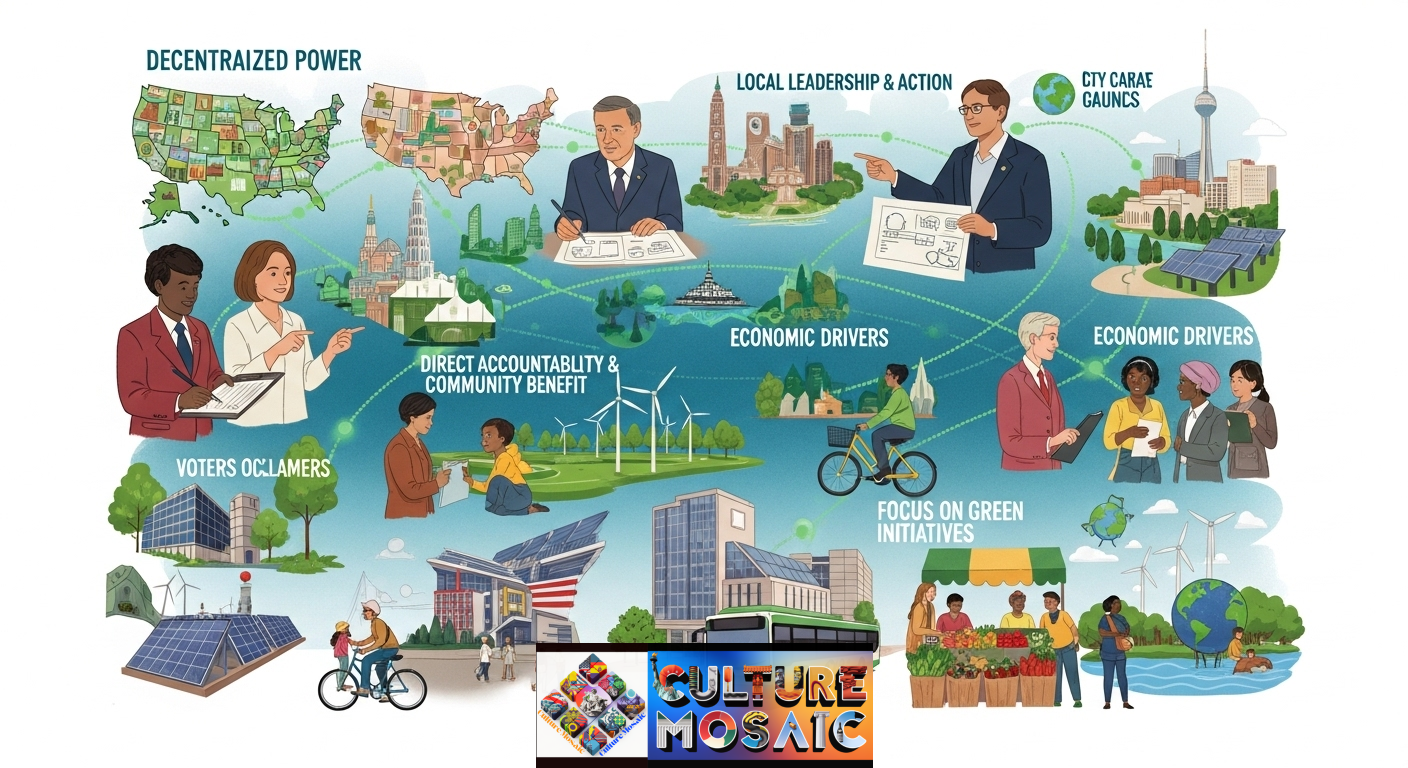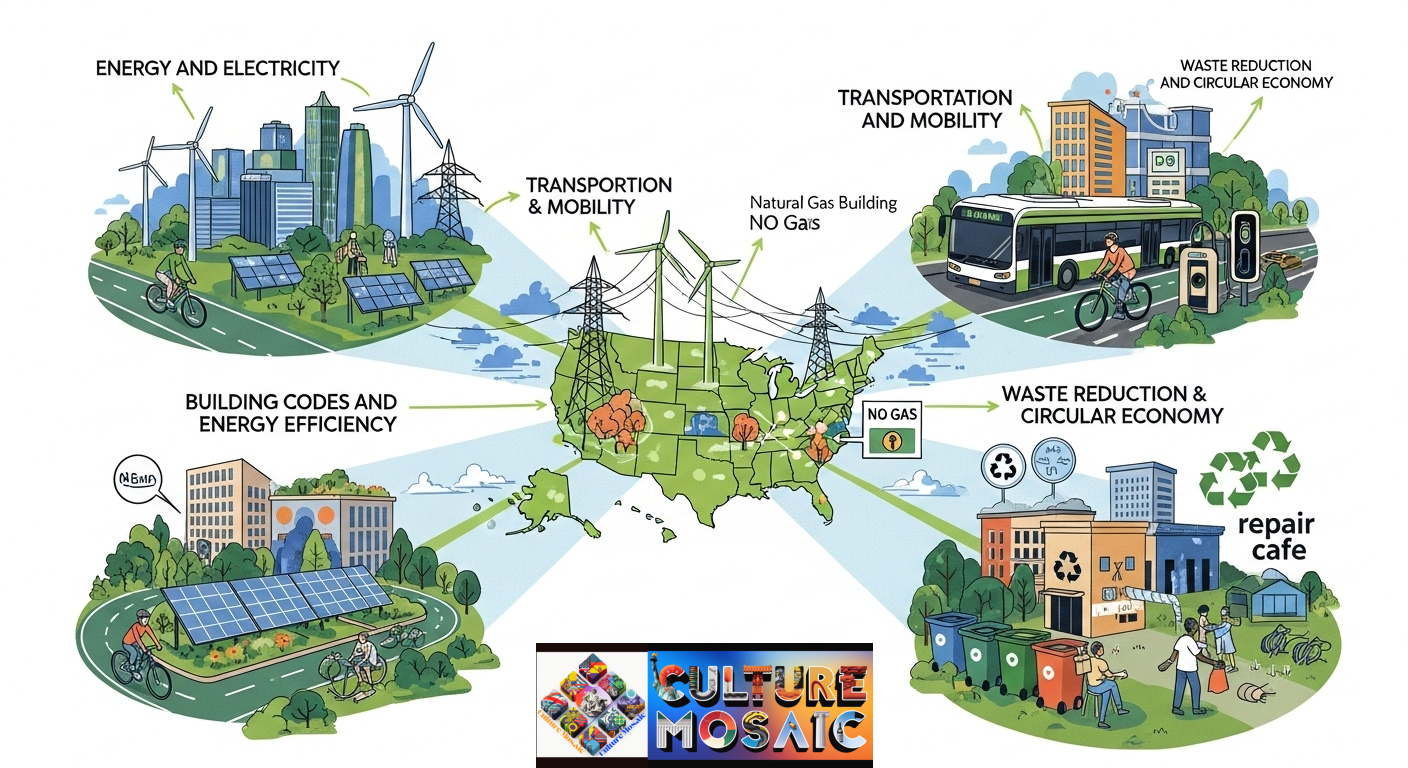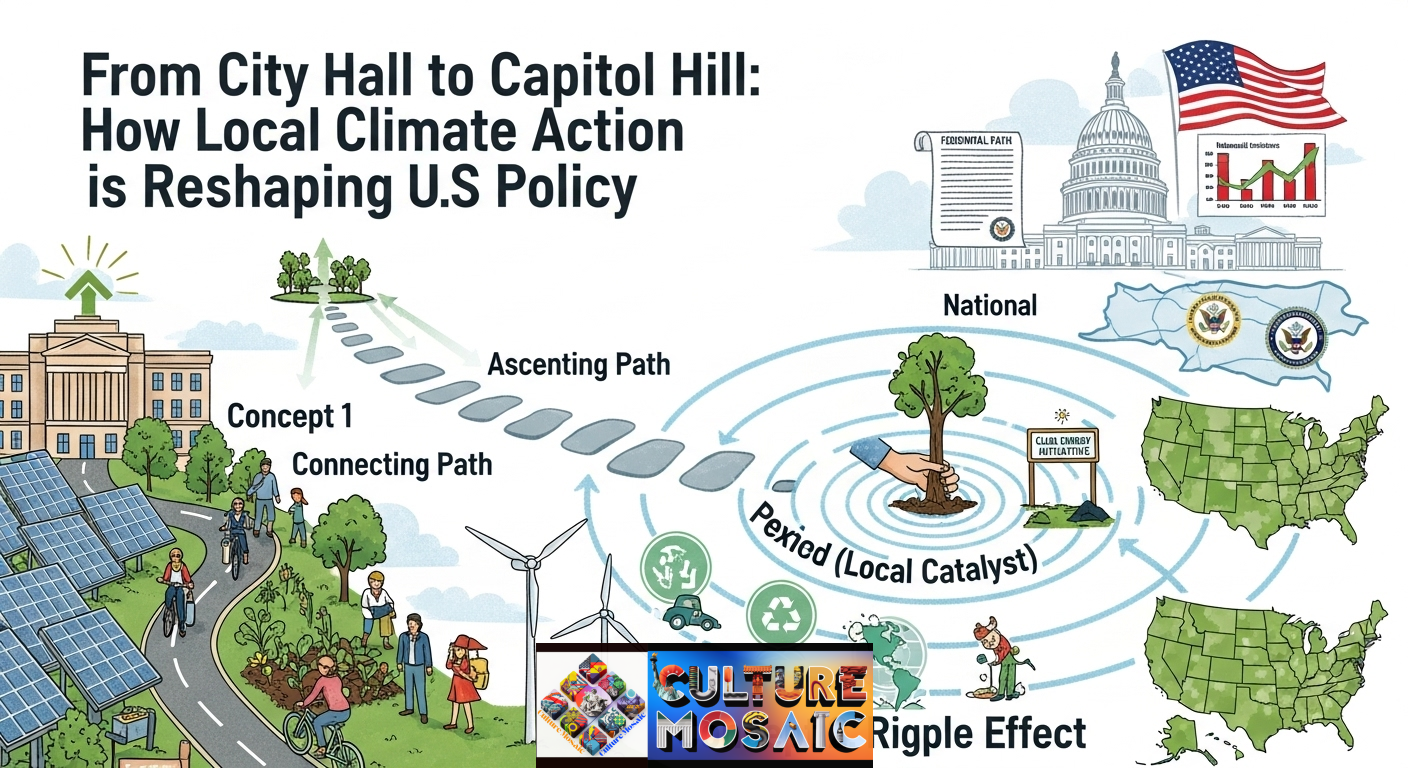This isn’t your typical environmental story. It’s about how local governments, grassroots organizers, and everyday citizens are cracking the code on climate progress. They’re proving that change doesn’t always need to start at the top. Sometimes, the most powerful policy shifts begin in a crowded city council meeting or a neighborhood planning session.
Understanding Local Climate Action US Policy
Local climate action US policy refers to environmental initiatives that start at the municipal or state level before influencing national standards. Think of it as democracy in action, where communities tackle climate change based on their specific needs, resources, and political landscapes.
This approach has gained momentum because local governments can move faster than federal agencies. They’re closer to the problems and the people affected by them. When a coastal city faces flooding, its leaders don’t wait for a federal study. They implement flood management systems, update building codes, and invest in resilient infrastructure.
The beauty of this system is its flexibility. What works in Austin might look different in Boston, but both cities can experiment, learn, and share results. This creates a laboratory of ideas where successful policies naturally spread to other communities.
Why Local Climate Action Works in the US System

The American political structure was designed to give states and cities significant autonomy. That’s working in favor of climate progress right now. While Congress debates comprehensive climate legislation, mayors and governors are signing executive orders, passing ordinances, and allocating budgets for green initiatives.
Local officials face direct accountability. If a mayor promises cleaner air and fails to deliver, voters remember at the next election. This pressure creates urgency that federal politicians sometimes lack. Plus, local leaders often have more bipartisan support for environmental projects because residents can see the immediate benefits in their communities.
Economic incentives also drive local climate action US policy. Cities compete for businesses and talent. Young professionals increasingly want to live in places with good public transit, clean energy, and environmental commitments. Progressive climate policies become economic development tools, not just environmental ones.
The Ripple Effect: How Local Wins Scale Up

Local Climate Action US Policy: California’s vehicle emission standards tell this story perfectly. The state set stricter rules than federal requirements in the 1960s, and automakers initially fought back. But California’s massive car market meant manufacturers couldn’t ignore it. Eventually, other states adopted similar standards, and federal policy shifted to accommodate them. Today, California’s electric vehicle mandates are influencing the entire American auto industry.
This pattern repeats across different sectors. When New York City required large buildings to reduce emissions, property owners and developers had to figure out solutions. The technologies and strategies they developed are now being deployed nationwide. The city essentially forced innovation that benefits everyone.
Local climate action US policy creates these ripple effects because successful models are hard to ignore. When a mid-sized city cuts emissions by 25% while growing its economy, neighboring cities take notice. State legislators see proof that ambitious goals are achievable. Federal policymakers eventually incorporate these tested approaches into national frameworks.
Key Areas Where Local Climate Action US Policy Leads

Energy and Electricity
Cities and states are transforming America’s energy landscape. Over 170 US cities have committed to 100% renewable electricity. Some, like Burlington, Vermont, have already achieved it. These commitments drive investment in solar, wind, and battery storage at scales that reshape regional energy markets.
Community solar programs, which allow residents to invest in shared solar arrays, started as local experiments. Now they’re expanding nationwide, making clean energy accessible to renters and people who can’t install rooftop panels. States like Minnesota and Colorado pioneered the model, showing how policy innovation moves from local to regional to national adoption.
Transportation and Mobility
Transportation accounts for the largest share of US greenhouse gas emissions. Local governments are responding with concrete solutions. Cities are expanding bike lanes, improving public transit, and creating car-free zones. These changes reduce emissions while making communities more livable.
Electric vehicle charging infrastructure began with city and state investments. Local governments installed the first public chargers, worked out the regulatory frameworks, and demonstrated demand. This groundwork made it easier for federal infrastructure bills to allocate billions for nationwide charging networks.
Some cities are going further. Seattle requires new buildings to include EV charging capacity. Los Angeles is electrifying its bus fleet. These local climate action US policy initiatives push the transportation sector toward cleaner alternatives faster than federal mandates alone could achieve.
Building Codes and Energy Efficiency
Buildings generate about 40% of US carbon emissions. Forward-thinking cities are rewriting the rules on construction and renovation. Berkeley, California, became the first US city to ban natural gas hookups in new buildings. Dozens of other cities followed, creating a movement that’s now facing both adoption and opposition in different regions.
New York City passed landmark legislation requiring large buildings to meet emission reduction targets or face substantial fines. Property owners are investing billions in efficiency upgrades, creating jobs and cutting pollution. The city’s approach provides a template that other municipalities can adapt to their contexts.
Energy efficiency standards for existing buildings are spreading from city to city. Boston, Washington DC, and other cities require energy audits and public reporting of building performance. This transparency drives improvements and helps residents and businesses make informed decisions.
Waste Reduction and Circular Economy
Cities generate most of America’s waste, so they’re natural leaders in waste reduction. San Francisco achieved an 80% landfill diversion rate through aggressive recycling, composting, and waste reduction programs. The city’s success proves that ambitious targets are realistic.
Plastic bag bans started in small California towns before spreading statewide, then to other states. The same pattern is emerging with plastic straws, Styrofoam containers, and single-use packaging. Local bans create consumer familiarity and business adaptation that make broader regulations easier to implement.
Zero-waste goals are moving from fringe ideas to mainstream policy. Cities are partnering with businesses to reduce packaging, establishing repair cafes to extend product life, and incentivizing circular economy approaches where materials are continuously reused.
The Grassroots Engine Behind Local Climate Action US Policy
Real policy change rarely happens in a vacuum. Behind most successful local climate initiatives are organized citizens who demanded action. These grassroots movements bring different tactics than traditional environmental groups.
Young activists use social media to mobilize supporters, document inaction, and celebrate wins. They pack city council meetings, organize petition drives, and hold officials accountable. This energy is forcing climate action onto local political agendas even in places where it wasn’t a priority.
Community organizations build coalitions across traditional divides. Environmental justice groups connect climate action with economic equity, showing how pollution disproportionately affects low-income neighborhoods and communities of color. This framing expands support beyond traditional environmentalist demographics.
Local climate action US policy often succeeds because it’s specific and tangible. Instead of abstract global targets, residents advocate for bike lanes on their street, solar panels on their school, or pollution reductions at a nearby factory. These concrete demands are easier to organize around and harder for officials to dismiss.
Case Study: How Boulder Built a Climate Policy Model
Local Climate Action US Policy: Boulder, Colorado, offers a masterclass in local climate action. The city set ambitious emission reduction targets decades ago and consistently met them through a combination of innovation and persistence.
Boulder created its own municipal utility to prioritize renewable energy when the incumbent provider wouldn’t commit to clean power. This bold move required voter approval, legal battles, and years of negotiation. The city eventually partnered with Xcel Energy on a compromise that achieved most goals while avoiding the costs and risks of going fully independent.
The city implemented a carbon tax in 2007, one of the first in the nation. Revenue funds energy efficiency programs, renewable energy projects, and climate adaptation measures. Residents see where their money goes, which maintains support for the tax.
Boulder’s approach combines regulation, incentives, and public investment. The city offers rebates for home energy improvements, requires new buildings to meet strict efficiency standards, and invests in public transit and bike infrastructure. This comprehensive strategy addresses emissions across multiple sectors simultaneously.
Other cities study Boulder’s successes and failures. The lessons learned about community engagement, policy design, and political strategy inform local climate action US policy development nationwide.
State-Level Climate Leadership
While cities drive innovation, states have the resources and authority to implement change at larger scales. California leads in comprehensive climate policy, but other states are making significant moves regardless of political leanings.
New York passed the Climate Leadership and Community Protection Act, requiring the state to get 70% of electricity from renewables by 2030 and reach net-zero emissions by 2050. The law includes strong environmental justice provisions ensuring benefits reach disadvantaged communities.
Even traditionally conservative states are embracing renewable energy for economic reasons. Texas leads the nation in wind power production because it makes financial sense. Iowa generates over 40% of its electricity from wind. These aren’t ideological decisions but pragmatic economic choices that happen to benefit the climate.
Regional coalitions amplify state efforts. The Regional Greenhouse Gas Initiative links northeastern and mid-Atlantic states in a cap-and-trade program for power plant emissions. The US Climate Alliance brings together states committed to Paris Agreement goals regardless of federal policy. These collaborations show how local climate action US policy can fill voids left by federal inaction.
Challenges Facing Local Climate Action US Policy
Progress isn’t uniform or unchallenged. Local climate initiatives face significant obstacles that slow or stop implementation.
Preemption laws are a major barrier. Some state legislatures have passed laws preventing cities from enacting certain environmental regulations. This top-down interference limits local democracy and innovation. Cities in Texas can’t ban plastic bags anymore because the state legislature prohibited such bans.
Funding constraints limit what cities can accomplish. Many climate solutions require upfront investment that smaller or financially stressed municipalities can’t afford. Federal and state grants help, but competition for funding is intense, and application processes can be burdensome.
Political polarization affects local climate action. Even though many climate solutions have broad support when framed around health, jobs, or energy savings, they become controversial when labeled as climate policy. Local leaders must navigate these political dynamics carefully.
Legal challenges from industry groups can delay or derail local initiatives. When Berkeley banned natural gas in new buildings, a restaurant association sued, claiming the city overstepped its authority. These legal battles are expensive and time-consuming, even when cities ultimately win.
The Federal Response to Local Climate Leadership
Federal policymakers are starting to recognize and support the local climate action US policy movement. Recent infrastructure and climate legislation includes significant funding for state and local projects.
The Inflation Reduction Act provides tax credits, grants, and loans that help cities and states implement climate solutions. These federal resources amplify what local governments can accomplish on their own.
Federal agencies are also learning from local success. The Environmental Protection Agency and Department of Energy study city and state programs to identify best practices. This feedback loop helps spread successful approaches more quickly.
However, federal policy still lags behind local ambition in many areas. Cities and states continue to push boundaries while federal standards catch up. This dynamic tension drives progress even when it creates complexity.
How Citizens Can Strengthen Local Climate Action US Policy
You don’t need to be an expert or full-time activist to influence local climate policy. Small, consistent actions by ordinary citizens drive real change.
Attend city council and planning commission meetings when climate issues are on the agenda. Public comment periods allow residents to voice support or concerns. Elected officials pay attention when multiple constituents show up or submit written comments on the same issue.
Join or support local environmental organizations. These groups organize campaigns, provide expertise on technical policy details, and coordinate citizen advocacy. They need volunteers, donations, and engaged members to be effective.
Vote in local elections and research candidates’ climate positions. Local races often have low turnout, so engaged voters have an outsized influence. Mayors, city council members, and county commissioners make decisions that directly impact local climate action US policy.
Support local businesses that prioritize sustainability. Economic signals matter. When consumers choose companies committed to environmental responsibility, it encourages others to follow suit and creates demand for supportive policies.
Start conversations in your community. Talk to neighbors about climate solutions relevant to your area. Build grassroots support for initiatives before they reach the formal policy stage. Social pressure and community norms influence what’s politically possible.
The Economic Opportunity in Local Climate Action
Local Climate Action US Policy: Climate policy isn’t just about preventing harm. It’s also about capturing economic benefits. Cities and states that move early on clean energy, efficiency, and sustainable infrastructure attract investment and jobs.
The renewable energy sector employs over 800,000 Americans, and most of those jobs are created by state and local policies that drive deployment. Solar installers, wind technicians, and efficiency specialists work in communities across the country because local governments created markets for their services.
Building retrofits for energy efficiency create construction jobs that can’t be outsourced. When cities require buildings to meet emission standards, property owners hire local contractors, engineers, and skilled trades workers to do the work.
Clean technology companies locate in cities with supportive policies and skilled workforces. This creates a positive cycle where climate leadership attracts businesses, which creates jobs, which builds political support for continued climate action.
Local climate action US policy can also reduce costs. Energy efficiency lowers utility bills for residents and businesses. Renewable energy provides price stability as fossil fuel costs fluctuate. Better public transit saves households money on car ownership. These economic benefits build durable public support.
Looking Ahead: The Future of Local Climate Action US Policy
Local climate leadership isn’t slowing down. If anything, it’s accelerating as more communities see results and climate impacts become harder to ignore.
Expect to see more aggressive building emission standards as cities compete to decarbonize their built environment. Heat pumps, better insulation, and electric appliances will become standard in new construction and major renovations.
Transportation electrification will continue spreading. More cities will add EV charging requirements to building codes, electrify municipal fleets, and invest in electric public transit. The infrastructure and consumer markets are reaching tipping points where adoption accelerates.
Climate adaptation will receive more attention alongside emission reduction. Cities are investing in resilient infrastructure, updating flood maps, creating cooling centers for heat waves, and planning for climate migration. These practical steps protect residents while demonstrating the reality of climate change.
Regional collaboration will increase. Cities and states will form more coalitions to share resources, coordinate policies, and increase their collective leverage. These networks amplify what individual communities can achieve.
The relationship between local climate action US policy, and federal policy will continue evolving. As more communities implement solutions and demonstrate results, federal policymakers will incorporate those lessons into national frameworks. The direction of influence flows both ways, creating a more responsive and effective system.
Why This Movement Matters
Local climate action US policy represents democracy working as intended. Communities identify problems, develop solutions, test approaches, and share lessons. Success spreads organically as other places adapt what works to their contexts.
This bottom-up approach builds resilience into America’s climate response. When federal policy stalls, state and local action continues. When one approach fails, others are being tested elsewhere. This diversity of effort increases the chances of finding effective solutions.
Most importantly, local climate action gives people agency. Climate change can feel overwhelming and hopeless when viewed as a global problem requiring international coordination. But when framed as a local challenge with tangible solutions, it becomes manageable. Residents can see their impact, hold leaders accountable, and celebrate wins.
The next time you hear about climate policy, remember that the most important action might not be happening in Washington. It could be in your city council, at your state capitol, or in a community meeting in your neighborhood. That’s where local climate action US policy is being written, one decision at a time.
Frequently Asked Questions About Local Climate Action US Policy
What is local climate action US policy, and why does it matter?
Local climate action US policy refers to environmental initiatives implemented by cities, counties, and states to reduce emissions and build climate resilience. It matters because local governments can often move faster than federal agencies, test innovative solutions, and address specific community needs. These local successes often scale up to influence state and national policy.
How can cities and states pass climate policies when the federal government hasn’t?
The US constitutional system gives significant authority to state and local governments. Cities control building codes, zoning, and local infrastructure. States regulate utilities, set their own emission standards, and allocate budgets for environmental programs. This federalist structure allows local climate action to proceed regardless of federal policy positions.
What are some examples of successful local climate action US policy?
California’s vehicle emission standards influenced the entire auto industry. New York City’s building emission requirements are driving billions in efficiency investments. Boulder, Colorado, created innovative funding mechanisms for renewable energy. Over 170 cities have committed to 100% renewable electricity. These examples show how local action creates real change.
How do local climate policies affect residents and businesses?
Effects vary by policy but often include lower energy costs through efficiency programs, cleaner air from reduced pollution, improved public transit options, and new job opportunities in clean energy sectors. Some policies require businesses to meet new standards, which can involve upfront costs but typically result in long-term savings and improved resilience.
Can I influence local climate action US policy in my community?
Absolutely. Attend city council meetings during climate discussions, join local environmental organizations, vote in local elections, and talk to neighbors about climate solutions. Local governments are responsive to engaged residents. Many successful climate policies started with a handful of citizens who showed up consistently and advocated for change.

